How to Create Related Lists Without Lookups in Salesforce
.svg)
Table of Contents
Handling complex data relationships in Salesforce can often feel like a puzzle missing key pieces. Standard Salesforce features often fall short when it comes to consolidating related records like opportunities or contacts under parent accounts. This leaves many users wondering: is there a way to easily view and manage related objects directly from a parent account?
A recent IdeaExchange post raised this very concern, emphasizing the need for out-of-the-box object roll-up capabilities. This is where AGrid’s Intelligent Related Lists shines.
Intelligent Related Lists in AGrid
With AGrid’s Intelligent Related Lists, Salesforce admins and end-users can bridge gaps in data relationships by establishing virtual links between objects. This feature enables the creation of dynamic, tailored views that surpass Salesforce’s default capabilities. Whether it involves accessing grandchild objects, sibling records, or unrelated data, AGrid streamlines workflows and ensures users can retrieve and analyze data efficiently.
This functionality enables you to:
- Define virtual relationships without relying on lookup or master-detail fields.
- Retrieve records dynamically based on specific conditions.
- Configure multi-level relationships, such as grandchild or sibling records, with ease.
For example, you can now display all Opportunity Products related to an Account’s Opportunities directly on the Account detail page—a task that standard Salesforce doesn’t support.
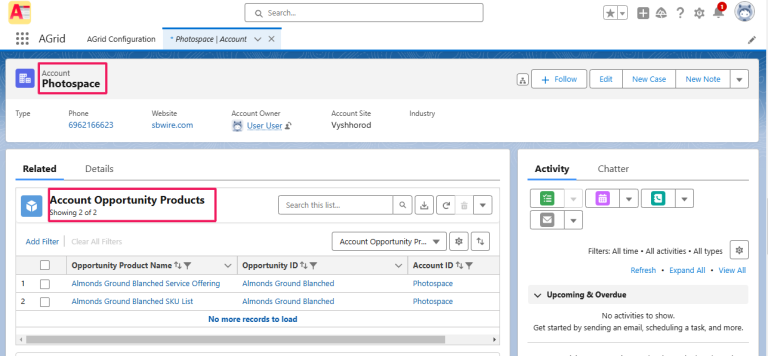
Key Features of Intelligent Related Lists
- Enhanced Record Retrieval: Create flexible relationships between objects to fetch records based on specific field values.
- Multi-Level Relationships: View grandchild objects, sibling records, and hierarchical children effortlessly.
- Customizable Filters: Use conditions and filters to fine-tune the relationships and data display.
- Dynamic Views: Add these lists to any Salesforce Lightning page to provide users with actionable insights.
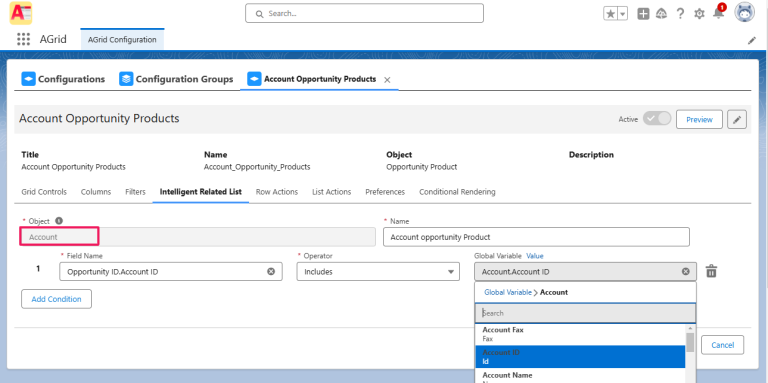
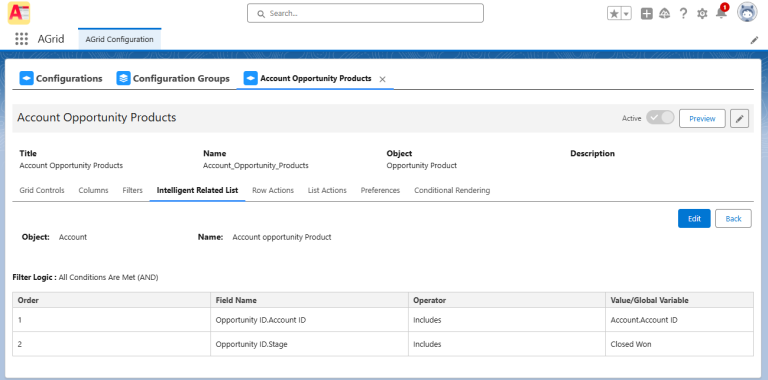
Configuration and Setup
Setting up Intelligent Related Lists in AGrid is straightforward:
- Create or Open a Configuration: Navigate to AGrid’s configuration page and either create a new configuration or open an existing one.
- Access the Intelligent Related List Tab: Click on the “Intelligent Related List” tab within the AGrid configuration interface.
- Set Up Relationships:
- Choose the object you wish to relate to and provide a unique name for the configuration.
- Define the relationship by setting up conditions and filters that determine how data is connected.
- Start by selecting the field on the source object you want to filter by, then match it with the corresponding field on the related object. Add specific criteria, such as matching field values, to narrow down results.
- To refine further, configure logical operators like AND/OR to create complex conditions that meet unique requirements. For example, you might filter records where “Stage = Closed” AND “Amount > 10,000.
- Save and Deploy:
- Finally, preview your configuration to confirm that it retrieves the intended data.
- Save your configuration and add it to a Lightning page to see it in action.
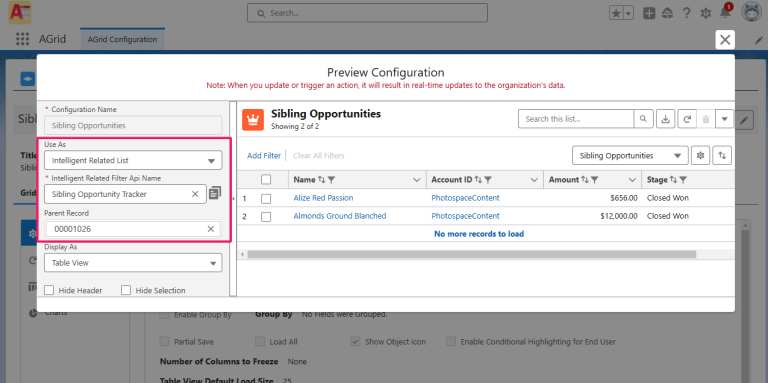
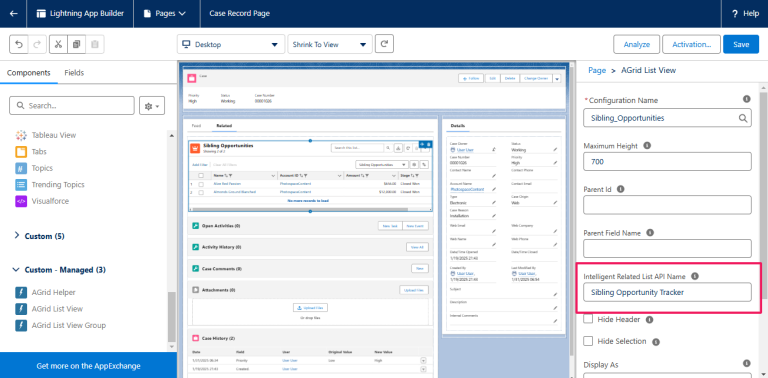
Use Cases
Here are some common use cases “Inteligent related list” feature can help you address
- Grandchild Objects: Display all Opportunity Products related to an Account’s Opportunities directly on the Account page.
- Sibling Records: Monitor sibling opportunities for a specific Account on a Case detail page.
- Hierarchical Relationships: View opportunities across an Account’s hierarchy up to five levels deep.
- Unrelated Records: Display cases linked to a Campaign’s related leads, even if no direct relationship exists in Salesforce.

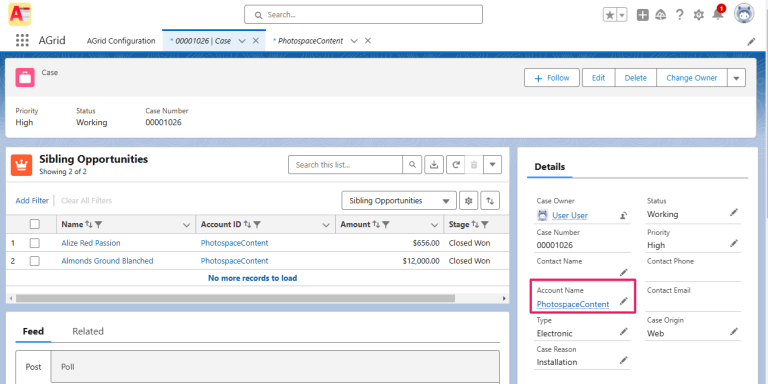
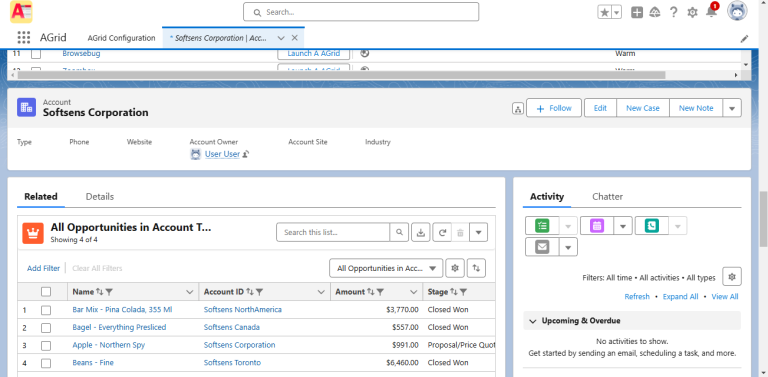
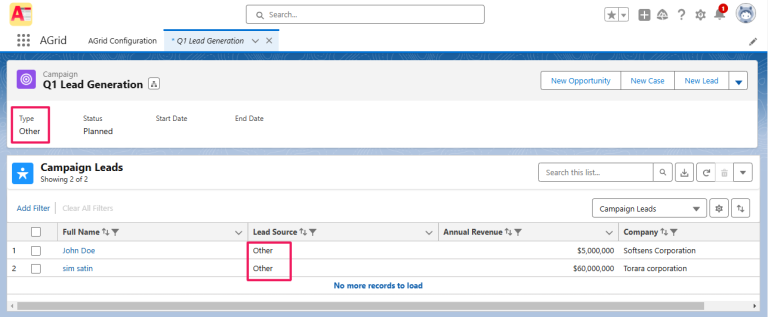
About AGrid
AGrid is a tool designed to make Salesforce data management simpler and more visual. Key features include:
- Inline Editing: Enable or disable inline editing for specific fields within list views, giving users the ability to update data quickly and efficiently.
- Conditional Formatting: Highlight rows, columns, or individual fields based on defined conditions, making critical data easy to spot in both list views and related list views.
- Auto-Refresh: Automatically update your data to ensure it’s always up-to-date without needing manual refresh.
- Grouping: Organize records within list views for better categorization and easier analysis.
- Summary Values: Automatically calculate and display summary values (e.g., totals, averages) directly within list views for quick, actionable insights.
- Custom Actions: Perform actions like invoking Salesforce Flows, Lightning Web Components (LWC), or Lightning Components (LC) directly from list views, streamlining workflows and boosting productivity.
And that’s just the beginning: features like preferences for personalized views, multi-level sorting, and bulk actions are just a few ways we make your Salesforce experience more powerful and efficient. There’s even more to explore!
What’s Next?
Does this get you excited to finally view complex object relationships as actionable related lists in Salesforce? Imagine rolling up opportunities, products, and more directly to parent accounts, all without complex configurations or lookups!
- Install AGrid today for a free trial and see Intelligent Related Lists in action.
- Contact us to explore how AGrid can streamline your data relationships and workflows.
- Dive into the AGrid Admin Manual for comprehensive guidance and tips.
Discover a new way to simplify and supercharge your Salesforce experience with AGrid.





